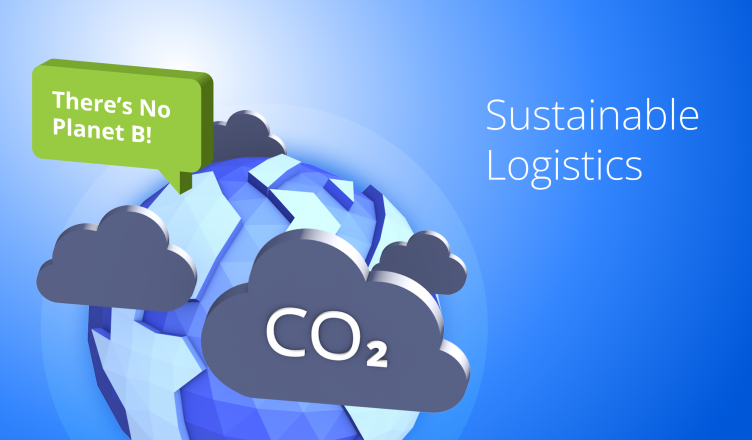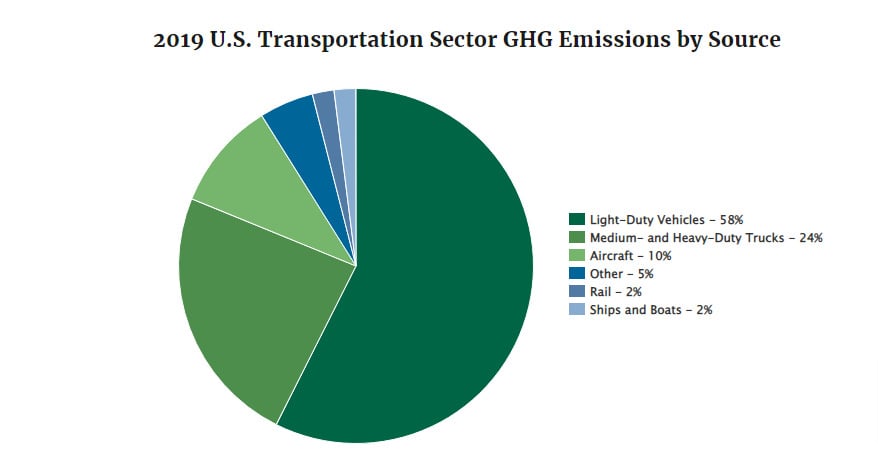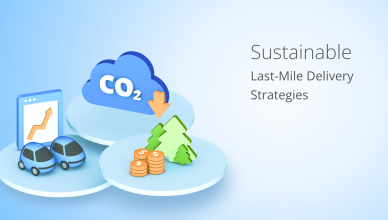Sustainable logistics is the need of the hour.
According to the United States Environmental Protection Agency, transportation is one of the most significant contributors (29%) to anthropogenic greenhouse gas emissions (GHG).
[Image credit: EPA]
Emissions from heavy-duty vehicles and light-duty vehicles are expected to contribute to the largest share of carbon dioxide emissions from this sector, totaling 38% and 36%, respectively, as per Statista’s report.
The combination of new government regulations, increased public demand for accountability, and the lack of automation are forcing many eCommerce, transportation, and logistics businesses to go green.
For example, FedEx has reduced CO2 emissions by around 40% since 2009 and aims to make its global operations carbon-neutral by 2040.
Amazon co-founded The Climate Pledge — a commitment to achieve net-zero carbon emissions by 2040. And eBay has set up two green campuses as part of a drive to use 100% renewable energy sources by 2025.
The reasons are simple. If appropriately implemented, green distribution helps reduce carbon emissions and contributes to the organization’s growth.
According to BCG research, from 2017 to 2020, the average annual total shareholder return (TSR) of transportation and logistics companies with concrete plans to negate carbon emissions was 10% higher than their industry peers.
There are many other advantages of sustainability in logistics, which we discuss below. We also share the best sustainable logistics practices you can implement in your organization.
Table of Contents
Benefits of Sustainable Logistics
There isn’t just one reason for the importance of sustainable logistics. Here are the top four reasons why you should consider sustainable logistics practices.
Helps You Win Bids with Logistics Tenders
According to Boston Consulting Group, more logistics tenders now include demand for emissions data. So, if your vehicles pollute less, you’ll have a greater chance of winning contracts.
Other factors that can help you win tenders include:
- Integrating reliable time calculations and GPS positioning data of the cargo
- Developing a cost-efficient subcontractor network
- Having a well-designed digital logistics management system
Improves Compliance with Government Guidelines
Depending on your business’s location, you could face many different environmental regulations and statutes from federal, state, or municipal governments. If your logistics services don’t support a certain level of sustainability, you could be on the hook for penalties, fines, and other civil consequences.
It’s not just the US; many countries worldwide have implemented strict regulations.
According to The Times, the British government plans to fine all listed companies in Britain if they don’t have a strategy in place regarding carbon emissions.
The objective behind such government-driven environmental regulations is to ensure that future generations have the resources to survive, and you have a share in this responsibility.
Adopting sustainable last-mile delivery practices will help you save money by achieving sustainability in transportation costs, but you can also avoid these potential consequences.
Increases Customer Affinity
Adopting carbon-neutral last-mile delivery practices increases customer affinity for your brand and wins you publicity and new business.
In fact, according to a study, consumers are ready to pay 5% more for online orders if delivered sustainably. Also, 76% of consumers are willing to wait for an extra day for climate-friendly transport.
Customers have also become more conscious about the type of products they purchase and how the sellers operate.
According to a Nielsen survey, 73% of consumers change their consumption habits to reduce their environmental impact. Another survey reveals that 43% of consumers prefer a business that offers green delivery options.
Social media has made sharing information about a business’s activities part of the lives of millions of customers, and your business’s image relies on your role and honesty in achieving a sustainable future.
Poor decisions could cause massive backlash and boycotts across social media channels, and your business will go down the drain in no time.
By having proven sustainability practices in place, you can minimize the inspection of your operations and improve the public’s perception of your business.
Improves Profitability
Often businesses hesitate to adopt sustainable logistics practices, fearing they are expensive. But that’s not always true.
You can comply with sustainability guidelines while maintaining a high-profit margin. These two don’t have to be mutually exclusive.
In fact, the profits of logistics companies with sustainable practices are up to 8% higher than those of companies with low environmental responsibility.
Although sustainable logistics is easier said than done, the use of advanced route planning and tracking tools (such as a route planner and GPS tracking software) can help you reduce last-mile emissions and comply with government regulations without compromising your profits.
Want To See For Yourself How Route4Me Can Boost Your Profits?

Best Sustainable Logistics Practices
Balancing profits and your environmental impact requires careful planning and consistency. Below are the critical elements of sustainable logistics you should consider to achieve this balance.
Use Route Optimization Software
A critical aspect of sustainable logistics is ensuring no empty runs. To make that happen, you need intelligent software like a route optimizer to optimize your drivers’ routes and loads.
Such software helps you plan fuel-efficient routes with accurate driving directions for delivery drivers, factoring in constraints like traffic congestion, weather, left turns, vehicle capabilities, roadblocks, and delivery time windows to ensure that your drivers make more stops per run while driving fewer miles. Such fewer miles mean low greenhouse gas emissions and reduced fuel costs.
Learn how to plan a route with multiple stops in 30 seconds.
The best route planners like Route4Me’s trucking GPS app do much more than just give you optimized routes. Here’s how it can help:
- It helps you assign a balanced workload so that none of your drivers are overworked, cover too many stops or underworked, and roam around unnecessarily, thereby reducing fuel consumption.
- The route optimizer offers a reporting and analytics feature to track fuel consumption.
- The route optimization software comes with a customer alerting and notification feature that helps you keep your customers informed about their orders automatically through email, SMS, or voice call. In this way, the customers will know when their orders are close, and you won’t need to reschedule deliveries, wasting fuel and emitting more carbon.
- It offers a customer portal that helps you save fuel in the same way as the feature above. Customers can log in to this portal and track their orders by themselves. This will help you avoid failed deliveries and increase first-time door opens.
Route4Me has prevented 10 billion miles from being driven and reduced CO2 emissions by over 10 Billion. And it cleaned up enough air, equal to planting more than 87 million trees. Learn more about Route4Me’s Environment and Sustainability (ESG) Initiatives.
Use Alternative Fuel or Vehicle Technologies for Sustainable Logistics
Most delivery trucks use diesel as a fuel source since it’s an affordable option. Unfortunately, diesel increases your carbon footprint by exhausting 13% more carbon than gas engines.
You can use lower-carbon fuels, such as biofuel, instead of fossil fuels or replace your old vehicles with electric vehicles to meet ecological and social sustainability goals.
Also, you should eliminate the emissions associated with distribution facilities with clean energy-powered electricity, water recycling, and solar systems.
Implement Eco-Driving Education for Sustainable Logistics
Did you know that driving between 55mph and 75mph can raise fuel consumption by as much as 20%?
In fact, you can improve gas mileage by 10% to 15% by driving at 55mph rather than 65mph.
Also, aggressive driving (speeding, braking, and accelerating) can reduce your gas mileage by 15% to 30% at highway speeds and 10% to 40% in stop-and-go traffic, as per the US Department of Energy.
That’s why eco-driving education is critical in reducing fuel consumption and GHG emissions. It also mitigates the risk of possible damage to the drivers and vehicle products.
It would be best to use an intelligent driver training solution that monitors your drivers’ driving behavior, personalizes and assigns training lessons accordingly, and then monitors their progress to confirm that they’re learning what they need to know.
Plus, you should use a GPS tracking app to monitor your drivers in real-time and ensure that they follow what you taught them.
The best route planners come with an app for GPS tracking, so you don’t need to buy a separate tracker but can instead plan routes and monitor activities from one software.
Offer Curbside Pickup to Make Your Logistics Sustainable
You can offer a curbside pickup service to enable your customers to collect their orders from a convenient location rather than delivering packages to their homes.
The pickup location could be the curb outside your store, warehouse, or elsewhere. It’ll help reduce fuel expenses as well as carbon emissions.
You might have to invest money to set up pickup locations, but it’s a one-time investment rather than the recurring costs of fuel, driver hiring and training expenses, etc.
You can use a curbside pickup app that integrates with your eCommerce store. Once integrated, you can receive, process, and complete thousands of pickups for multiple pickup locations, using only your smartphone.
For example, Route4Me offers a curbside pickup app that helps you:
- Manage multiple pickup stores,
- Ensure you never miss customer pickups and
- Prepare customer orders before they arrive, saving you time on order matching.
It also ensures that you always give the right order to the right customer and lets you see the status of each scheduled or completed customer curbside pickup or in-store pickup order.
Here’s a quick guide to curbside pickup.
Conclusion about Sustainable Logistics
Hurricanes, wildfires, and other natural calamities are increasing due to climate change. And carbon emissions from vehicles are one of the most significant contributors to that.
The governments are formulating policies and taking decisive actions to slow climate change. And you must comply with the new guidelines that set acceptable emissions levels for your fleet.
Adopting green logistics practices will not only help meet regulations but will also reduce carbon footprint. It’ll also grow your top line, improve your bottom line, and strengthen your supply chain.
Long story short, sustainable logistics is no longer just an option. Embrace it, or your company may teeter on the verge of closure.
There are many ways you can make your logistics green. You can reduce waste and adopt clean energy resources. You can also invest in eco-friendly technologies to create a sustainable supply chain in a journey to become carbon neutral.
Want To See For Yourself How Route4Me Can Boost Your Profits?





